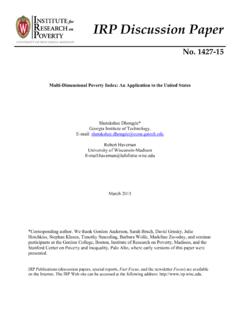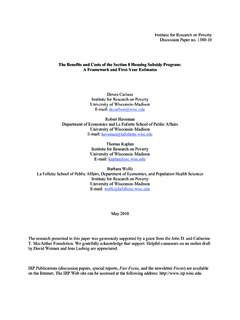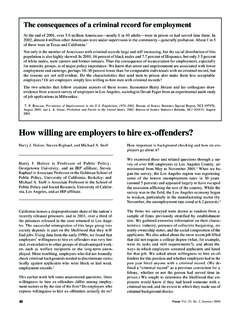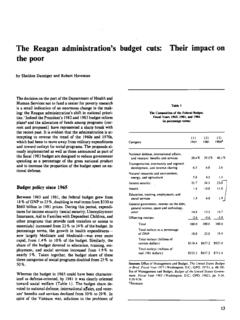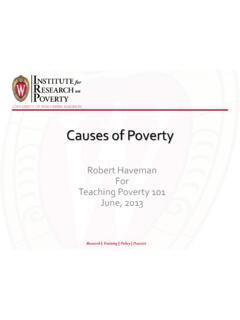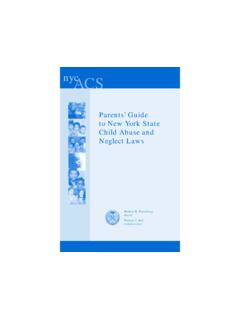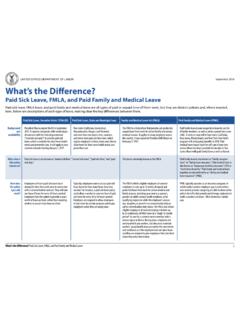Transcription of What we know about the effects of foster care
1 What we know about the effects of foster care Social agencies have no more awesome power than the right-with due process of law-to take children from their parents for an indefinite period of time and dispose of them as they see fit. Although no one disputes the need for foster care , no one endorses it as a solution to the problems for which it is invoked. When children are abused or neglected by their parents, or when the parents cannot-for any of a number of reasons- care for their children, someone must intervene to see that the children are adequately looked after. That someone is usually the government, and the intervention is frequently foster care . "There has always been, and will always be, a tension in the child welfare field between child saving and family preser- vation.
2 "' To the question, "What is best for the child?" no firm answer can be given because the parenting behavior of families in stress is highly unpredictable, and the impact of foster care remains to be measured. In an effort to explore the consequences of foster care , Thomas McDonald, Reva Allen, Alex Westerfelt, and Irving Piliavin, with the sup- port of the Institute for Research on Poverty, have carried out an extensive review of the research that has been done on one aspectdoubtless the most important--of foster care (see box). They focus on "outcomes," that is, the long- term effects of foster care on the functioning of adolescents and adults. foster care is care for children outside the home that substi- tutes for parental care .
3 The child may be placed with a family, relatives or strangers, in a group home (where up to a dozen foster children live under the continuous supervi- sion of a parental figure), or in an institution. Whatever its form, foster care is an enormous upheaval in the life of a child, who often must adjust not only to a different family, a different location, a different school, and different peers, but to a different culture as well. Important decisions con- cerning the lives of foster children are in the hands of strangers-courts, social welfare agencies, substitute par- ents, any one of which may have custody of the child. At the same time the biological parents may maintain their physical and emotional ties with the child.
4 In fact these ties are considered crucial, for the essence of foster care is that it is a temporary expedient, since "it is generally agreed that it is in the best interests of children to live with their fa mi lie^."^ Yet it is argued that this temporary expedient often becomes a permanent state, from which the child escapes only into adulthood and putative independence.' The adjustment to foster care would be difficult enough for children from stable backgrounds, but the children requir- ing foster care can seldom be so described. Most-between 75 and 80 percent-are taken from their homes because their parents fail to care for them adequately. The failure may be brought about by a sudden calamity, such as physi- cal or mental illness or imprisonment of the care -giving parent.
5 Or the parents may be drug addicts, oblivious of parental responsibilities. Or they may abuse, neglect, or abandon their ~hildren.~ Between 15 and 20 percent of foster children enter the system because they have problems with which the parents cannot The child may, for example, be retarded or have mental or physical handicaps. Less than 5 percent of the cases are caused primarily by environmental factors such as financial need, inadequate housing, or chronic un- employment, but poverty frequently contributes to the cri- ses that require children to be placed in foster History of foster care Unprotected children have not fared well over the course of history. Children are the quintessential victims: helpless, delicate, and demanding.
6 Infanticide and abandonment are as old as recorded history (witness Oedipus) and are thought to still be commonplace in countries with large poor populations. In many instances such extreme mea- sures were deemed necessary-when, for example, there was insufficient food to go around. Churches and workhouses gradually lessened the outright murder of infants in Europe after the Middle Ages, al- though the vast majority of infants placed in foundling homes died in their first year. Because older children had some economic value for the work they could perform, they were indentured. Indeed they were not considered children, but rather small adults as far as work was concerned, except they had none of the rights of adults.
7 In Tudor England, children reached the age of majority at nine. David Copperfield and Oliver Twist bear witness to the life of such children in the nineteenth century. At that time laws pertaining to cruelty to animals were much more stringent than laws dealing with cruelty to children, and in at least one case, a child was removed from abusing parents on the grounds that she was a member of the animal kingd~m.~ Assessing the Long-Term effects of foster care : A Research Synthesis by Thomas McDonald, Reva Allen, Alex Westerfelt, and Irving Piliavin IRP Special Report. Forthcoming The rights of children have only gradually been estab- lished: Until recently parental rights were considered invio- late.
8 The United Nations Declaration of the Rights of the Child in November 1954 was an important milestone in stating the rights that children should And in the United states a number of legal rights for children have emerged, often in conflict with the rights of parenkg The first well-known foster family care program in the United states was The Placing Out System of the New york Children's Aid Society. This program was estab- lished by Charles Loring Brace in 1853, with the goal of disposing of vagrant children. Children were rounded up from the city streets and obtained from institutions and shipped to rural communities in the West or South, where committees of citizens arranged for them to be taken in by families.
9 A description of the procedure makes it sound like a slave auction, and it was generally conceded that the motives of the families with whom the children were placed had more to do with self-interest than Christian Though many of the children were not orphans, they were permanently severed from their biological families. Despite some opposition, the idea caught on, and by 1923 thirty-four states contained private organizations engaged in shipping children to communities far from their homes, and it is estimated that 100,000 children were placed from New york City alone between 1854 and 1929." The evolution of foster family care is closely related to the evolution of substitute care in institutions.
10 At about the same time that The Placing Out system came into use, about twenty states opened public orphanages to provide temporary homes for destitute children. These orphanages were thought to be a great improvement over the almshouses, which housed not only children, but insane, senile, and diseased adults. However, for many years a debate raged over whether an institution or a foster family home was more desirable. As more and more states passed laws prohibiting the placement of children in almshouses, foster family care came into wider use. The concept of foster family care eventually won out and was recom- mended as the best substitute for a natural home at a White House Conference on Children in The rate of children in substitute care of all kinds appears to have peaked in the early 1930s.



